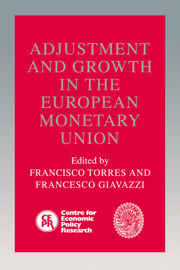Book contents
- Frontmatter
- Contents
- List of figures
- List of tables
- Preface
- List of contributors
- Foreword
- 1 Introduction
- 2 Economic and monetary union: critical notes on the Maastricht Treaty revisions
- Discussion
- 3 The design of optimal fiscal rules for Europe after 1992
- Discussion
- 4 Contracts, credibility and common knowledge: their influence on inflation convergence
- Discussion
- 5 Inflation in fixed exchange regimes: the recent Portuguese experience
- Discussion
- 6 Models of economic integration and localized growth
- Discussion
- 7 Shocking aspects of European monetary integration
- Discussion
- 8 Lessons of Massachusetts for EMU
- Discussion
- 9 Financial and currency integration in the European monetary system: the statistical record
- Discussion
- 10 Currency substitution: from the policy questions to the theory and back
- Discussion
- 11 Coordination of capital income taxes in the economic and monetary union: what needs to be done?
- Discussion
- Index
Discussion
Published online by Cambridge University Press: 29 January 2010
- Frontmatter
- Contents
- List of figures
- List of tables
- Preface
- List of contributors
- Foreword
- 1 Introduction
- 2 Economic and monetary union: critical notes on the Maastricht Treaty revisions
- Discussion
- 3 The design of optimal fiscal rules for Europe after 1992
- Discussion
- 4 Contracts, credibility and common knowledge: their influence on inflation convergence
- Discussion
- 5 Inflation in fixed exchange regimes: the recent Portuguese experience
- Discussion
- 6 Models of economic integration and localized growth
- Discussion
- 7 Shocking aspects of European monetary integration
- Discussion
- 8 Lessons of Massachusetts for EMU
- Discussion
- 9 Financial and currency integration in the European monetary system: the statistical record
- Discussion
- 10 Currency substitution: from the policy questions to the theory and back
- Discussion
- 11 Coordination of capital income taxes in the economic and monetary union: what needs to be done?
- Discussion
- Index
Summary
The chapter by Niels Thygesen makes an important contribution towards our understanding of the institutional and economic contents of Stage II of EMU. I will focus my comments on three issues: (i) differences between Stages I and II; (ii) stability in Stage II, and (iii) convergence criteria for entering into Stage III.
Differences between Stage I and Stage II
I agree with the author that the Maastricht Treaty is a major step foward in the construction of EMU since it shows the political will to complete the process in a limited time horizon. I also share the view that at the heart of the compromise reached at Maastricht lies the principle of indivisibility; namely, that monetary sovereignty will remain firmly in the hands of the national authorities until the beginning of Stage III. This is critical to understanding why there will not be any gradual transfer of monetary sovereignty in Stage II from the national sphere towards the central monetary institution – the EMI – as originally envisaged by the Delors Report. As a result, Stage II will represent mainly an intensification of the process of monetary co-ordination already present in Stage I together with some elements of institutional preparation for Stage III.
Niels Thygesen would have liked to see a qualitiatively different Stage II with more monetary content and where the EMI had been empowered to use monetary instruments to regulate the overall monetary conditions in the Community.
- Type
- Chapter
- Information
- Adjustment and Growth in the European Monetary Union , pp. 41 - 45Publisher: Cambridge University PressPrint publication year: 1993



